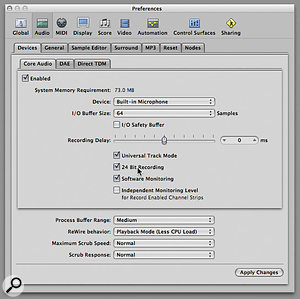Is 24-bit recording any better than 16-bit
recording in a home studio, given that the only qualitative difference
is (apparently) the noise floor? In 99.9 percent of home studios, this
difference will be masked by the ambient noise of the studio, and by
preamp or mic self-noise. From what I've learnt from Hugh's articles on
digital audio, I'm sceptical. Is it really worth me switching from
16-bit to 24-bit recording?
SOS Forum Post
Recording at 24-bit increases the available headroom in the system, although this may not offer any practical benefits for signals recorded with microphones in an average home studio.
Technical Editor Hugh Robjohns replies: The characteristic defined by the word length is the available dynamic range, or where the noise floor sits in relation to the peak level. A properly dithered 16-bit system provides a dynamic range of around 93dB, while a mid-budget 24-bit system should be able to deliver something around
115dB or so. The implication, then, is that you could work with about 20dB more headroom in a 24-bit system without any increase in the apparent system noise over the 16-bit mode. For most people, the additional computer overhead of operating with 24-bit word lengths instead of 16 has a negligible effect on processing power, and the additional file-storage requirements are inconsequential, given the size of modern hard disks, so the lower system noise and greater headroom margins are a welcome benefit for a negligible cost.
Having said all that, you are right in that for most people recording at home, the recording noise floor is almost always defined by the ambient room noise rather than the digital system noise. Therefore, you can usually work with reasonable headroom margins at 16-bit word lengths while maintaining the ambient noise floor comfortably above the system noise floor. In other words, the dynamic range of the source recordings is typically far less than the capability of a 16-bit recording system. Where that changes is if you record electrical instruments such as guitars and keyboards via DIs. In these cases, the noise floor is often far lower than that possible when recording with microphones in a home studio, so the dynamic range of a 16-bit system may start to become a limitation.
The bottom line is, if you are happy with the results you get with 16-bit, there may be no benefit in changing to 24. However, most people do find that 24-bit working enables greater headroom margins without noise penalties, and that in turn makes recording less stressful and mixing rather easier. Personally, I can see no negative side to recording at 24-bit, and only positive benefits.
Published June 2008
No comments:
Post a Comment